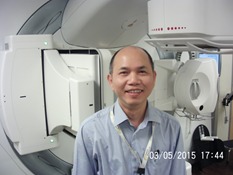Program Information
TG-129 Implementation On BrachyvisionTM
A Nguyen1,2*, Y Hu1 , R He1 , T Paul2 , A Plowman3 , P Mobit3, J Ma1 , S Packianathan1 , M Kanakamedala1 , C Yang1 , (1) University of Mississippi Medical Center, Jackson, MS, (2) Ironwood CRC, Chandler, AZ, (3) Remote Dosmetry Services, Lucedale, MS
Presentations
SU-E-T-414 Sunday 3:00PM - 6:00PM Room: Exhibit HallPurpose: To outline the steps taken to clinically implement TG-129 on BrachyvisionTM Treatment Planning System and to show the dosimetric differences that can be expected from the original COMS Eye Plaque model.
Methods: The original COMS-Eye Plaque protocol was based on the following simplification: point source model in infinite water medium, 1D geometric function, 1D radial dose function and no anisotropy. Recently, AAPM Task Group 129 had made two specific recommendations: 1> Upgrade to TG-43U1 line source model; and 2> Report the heterogeneity corrected dose. Upgrading to line TG-43U1 line source model was done by a creating a seed collection in Brachyvision (version 11) for each plaque size. For each seed in the collection, both end coordinates had to be entered into the software. Full line source model was followed to compute the homogeneous dose at the prescription point. This homogeneous dose was converted to heterogeneous dose using a conversion table. Dose to prescription points for five different plaque sizes, including one customized notched plaque, was calculated using the implemented TG-129 model and compared against actual COMS derived doses from previously treated patient plans. Conversion to heterogeneous doses was done based on table 2 of TG-129 report.
Results: As expected, dose difference between COMS and TG-129 was relatively minor, ranging from -0.15% to 1.91% at the prescription point. On the other hand, heterogeneous dose, which should be used for reporting purpose only, can be up to ~17% lower than the corresponding homogeneous dose.
Conclusion: Conversion to TG-129 can be rapidly accomplished in 1-2 weeks. The initial time investment can be quickly recouped since the TPS plans created can be modified for different patient cases. Dosimetric difference between TG-129 and the original COMS model is small, generally less than 2%.
Contact Email:


